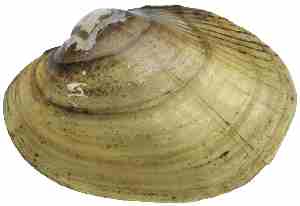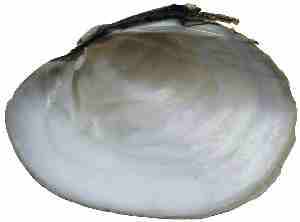Yellow Lampmussel
Lampsilis cariosa
Endangered Species
Key Features
Size: Up to five inches.
Shape: Ovate. Valves laterally inflated. Mature females usually more rounded toward the posterior ventral margin. Valves strong and thick, particularly toward the anterior end.
Periostracum: Color bright yellow in young individuals, sometimes becoming yellowish-brown with age. Faint green shell rays present on the dorso-posterior slope, particularly evident on young specimens.
Lateral Teeth: Present. Two on the left valve and one on the right valve.
Pseudocardinal Teeth: Present. Two on the left valve and two or three on the right valve. The teeth are stout, with striations on the surface, and usually located directly under the beak [this is an important feature for distinguishing this species from the tidewater mucket].
Nacre: Color white or bluish-white. Nacre thicker and more lightly colored toward the anterior end.
Often Confused With ... Tidewater mucket, eastern lampmussel

External shell

Internal shell, right valve

Hinge teeth
Habitat: The yellow lampmussel inhabits medium to large-sized rivers and lakes, and exists in a variety of substrate types.
Range in Connecticut: Rediscovered in 2006 in the Connecticut River.
Conservation: Though historically known from the Housatonic watershed, this species has not been documented in this watershed since the 1960s. The yellow lampmussel is listed as endangered in Massachusetts and threatened in Maine.
Freshwater Mussel Fact Sheets
Eastern Pearlshell
Dwarf Wedgemussel
Triangle Floater
Brook Floater
Creeper
Eastern Elliptio
Eastern Floater
Alewife Floater
Eastern Pondmussel
Tidewater Mucket
Yellow Lampmussel
Eastern Lampmussel
The Freshwater Mussels of Connecticut
Content last updated on January 29, 2014.

